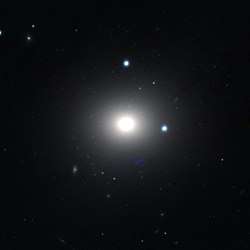NGC 1395
NGC 1395 is an elliptical galaxy located in the constellation Eridanus. It is located at a distance of circa 75 million light years from Earth, which, given its apparent dimensions, means that NGC 1395 is about 130,000 light years across.[1] It was discovered by William Herschel on November 17, 1784.[2] It is a member of the Eridanus Cluster.
| NGC 1395 | |
|---|---|
 NGC 1395 by PanSTARRS | |
| Observation data (J2000 epoch) | |
| Constellation | Eridanus |
| Right ascension | 03h 38m 29.8s[1] |
| Declination | −23° 01′ 39″[1] |
| Redshift | 0.005727 +/- 0.000022 [1] |
| Helio radial velocity | 1,717 ± 7 km/s[1] |
| Distance | 74.4 ± 17.8 Mly (22.8 ± 5.4 Mpc)[1] |
| Apparent magnitude (V) | 9.8 |
| Characteristics | |
| Type | E2 [1] |
| Apparent size (V) | 5′.9 × 4′.5[1] |
| Other designations | |
| ESO 482- G019, AM 0336-231, MCG -04-09-039, PGC 13419[1] | |
Characteristics
In the centre of NGC 1395 lies a supermassive black hole whose mass is estimated to be 3.9×108 (108.59) M☉ based on the M–sigma relation[3] or between 100 and 257 million (108 – 108.41) M☉ based on the Sérsic index of the galaxy.[4] NGC 1395 emits X-rays which have been observed by Chandra Space Telescope and XMM-Newton. The luminosity of the galaxy in X-rays is 3×1040 ergs and is believed it is emitted by hot gas with total mass 4.1×108 M☉.[5] One other source of X-ray emission in early type galaxies are X-ray binary stars, with 24 sources being detected in the inner area of NGC 1395.[6]
NGC 1395 is home to a large number of globular clusters, with their total number estimated to be 6000±1100, compared to 150–200 in and around the Milky Way. There are two different populations of globular clusters in the galaxy, named blue and red from their photometric color. The clusters of the red subpopulation lie closer to the centre of the galaxy while the blue ones lie mostly in the halo. The surface density profile of the blue globular clusters indicates that the galaxy has accreted a significant number of dwarf satellites.[7]
David Malin and Dave Carter discovered in 1983 low contrast shells in the bright envelope of NGC 1395.[8] The brightest shell lies 3 arcminutes northwest of the galactic centre.[7] A perpendicular feature is seen also in deep imaging in the northwest part of the galaxy.[9] Features like these are indicative of recent accretion of a smaller galaxy in the recent past.[7]
Nearby galaxies
NGC 1395 is part of the Eridanus Cluster and is the brightest member of the NGC 1395 subgroup. Other members of this subgroup are the galaxies IC 1952, NGC 1401, NGC 1414, NGC 1415, NGC 1422, NGC 1426, NGC 1438, and NGC 1439.[10]
References
- "NASA/IPAC Extragalactic Database". Results for NGC 1395. Retrieved 2016-01-18.
- Seligman, Courtney. "NGC 1395 (= PGC 13419)". Celestial Atlas. Retrieved 19 November 2018.
- Pellegrini, S. (2010). "The Nuclear X-ray Emission of Nearby Early-type Galaxies". The Astrophysical Journal. 717 (2): 640–652. arXiv:1005.2344. Bibcode:2010ApJ...717..640P. doi:10.1088/0004-637X/717/2/640. ISSN 0004-637X.
- Mutlu-Pakdil, Burçin; Seigar, Marc S.; Davis, Benjamin L. (17 October 2016). "The local black hole mass function derived from the MBH-P and the MBH-n relations". The Astrophysical Journal. 830 (2): 117. arXiv:1607.07325. Bibcode:2016ApJ...830..117M. doi:10.3847/0004-637X/830/2/117.
- Su, Yuanyuan; Irwin, Jimmy A. (7 March 2013). "Investigating the potential dilution of the metal content of hot gas in early-type galaxies by accreted cold gas". The Astrophysical Journal. 766 (1): 61. arXiv:1301.7706. Bibcode:2013ApJ...766...61S. doi:10.1088/0004-637X/766/1/61.
- Vagshette, N.D.; Pandge, M.B.; Patil, M.K. (July 2013). "Spectral properties of XRBs in dusty early-type galaxies". New Astronomy. 21: 1–7. arXiv:1205.6057. Bibcode:2013NewA...21....1V. doi:10.1016/j.newast.2012.10.005.
- Escudero, Carlos G; Faifer, Favio R; Smith Castelli, Analía V; Forte, Juan C; Sesto, Leandro A; González, Nélida M; Scalia, María C (March 2018). "Tracing the assembly history of NGC 1395 through its Globular Cluster System". Monthly Notices of the Royal Astronomical Society. 474 (4): 4302–4321. arXiv:1711.08046. Bibcode:2018MNRAS.474.4302E. doi:10.1093/mnras/stx3045.
- Malin, D. F.; Carter, D. (November 1983). "A catalog of elliptical galaxies with shells". The Astrophysical Journal. 274: 534. Bibcode:1983ApJ...274..534M. doi:10.1086/161467.
- Tal, Tomer; van Dokkum, Pieter G.; Nelan, Jenica; Bezanson, Rachel (1 November 2009). "THE FREQUENCY OF TIDAL FEATURES ASSOCIATED WITH NEARBY LUMINOUS ELLIPTICAL GALAXIES FROM A STATISTICALLY COMPLETE SAMPLE". The Astronomical Journal. 138 (5): 1417–1427. arXiv:0908.1382. Bibcode:2009AJ....138.1417T. doi:10.1088/0004-6256/138/5/1417.
- Makarov, Dmitry; Karachentsev, Igor (21 April 2011). "Galaxy groups and clouds in the local (z∼ 0.01) Universe". Monthly Notices of the Royal Astronomical Society. 412 (4): 2498–2520. arXiv:1011.6277. Bibcode:2011MNRAS.412.2498M. doi:10.1111/j.1365-2966.2010.18071.x.
External links
| Wikimedia Commons has media related to NGC 1395. |
- NGC 1395 on WikiSky: DSS2, SDSS, GALEX, IRAS, Hydrogen α, X-Ray, Astrophoto, Sky Map, Articles and images
- NGC 1395 on SIMBAD